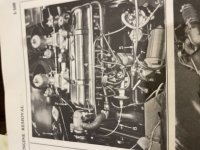Offline
I’ve discovered that there is a material difference in the temperature of the gasoline in my front SU HS6 float bowl compared to the rear float bowl.
The front is showing 132° in mid afternoon driving, and the rear is showing 148 to 152°. I’m told that the boiling point for gasoline, especially with ethanol, is right about 150°.
I assume this is a material part of the problem I’ve been having with mid afternoon driving, idling at stoplights, etc.
In carefully checking the operation of the engine, I can see there is definitely a blast of hot air coming off the exhaust manifold, and which is directed by my fans, standard plus auxiliary, toward the rear of the engine compartment.
This must explain the difference.
I have a heat shield and I’ve tried applying some reflective insulating material. Neither has been helpful reducing the temperature of that rear float bowl.
A suggestion has been made that I put fabric heat shield over the steel shield that I already have. I just don’t know.
I am wondering whether anyone else has encountered this, and what other ideas you might have.
The front is showing 132° in mid afternoon driving, and the rear is showing 148 to 152°. I’m told that the boiling point for gasoline, especially with ethanol, is right about 150°.
I assume this is a material part of the problem I’ve been having with mid afternoon driving, idling at stoplights, etc.
In carefully checking the operation of the engine, I can see there is definitely a blast of hot air coming off the exhaust manifold, and which is directed by my fans, standard plus auxiliary, toward the rear of the engine compartment.
This must explain the difference.
I have a heat shield and I’ve tried applying some reflective insulating material. Neither has been helpful reducing the temperature of that rear float bowl.
A suggestion has been made that I put fabric heat shield over the steel shield that I already have. I just don’t know.
I am wondering whether anyone else has encountered this, and what other ideas you might have.
Last edited:

 Hi Guest!
Hi Guest!

 smilie in place of the real @
smilie in place of the real @
 Pretty Please - add it to our Events forum(s) and add to the calendar! >>
Pretty Please - add it to our Events forum(s) and add to the calendar! >> 

